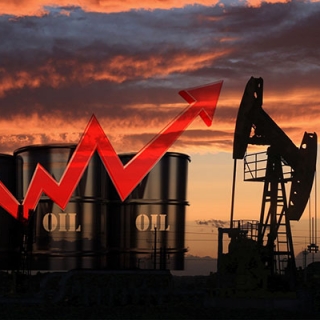


Oil prices plunged 2% to a 4-year low on Monday on concerns that U.S. President Donald Trump's latest trade tariffs could push economies around the world into recession and dent global demand for energy.
Brent crude futures fell $1.37, or 2.1%, to settle at $64.21 a barrel, while U.S. West Texas Intermediate crude futures fell $1.29, or 2.1%, to settle at $60.70.
That pushed both crude benchmarks, which fell about 11% last week, to their lowest closes since April 2021.
The trading session was marked by extreme volatility, with prices dropping more than $3 a barrel intraday overnight and rising more than $1 early Monday after a news report said Trump was considering a 90-day tariff pause. White House officials quickly denied the report, sending crude prices back into the red.
Confirming investor fears that a global trade war has begun, China, the world's second-largest economy after the U.S., said on Friday it would impose an additional 34% tariff on American goods in retaliation for Trump's latest tariffs.
Trump responded that the U.S. would impose an additional 50% tariff on China if Beijing did not withdraw its retaliatory tariffs on the U.S., and said "all talks with China about the meeting that they requested with us will be stopped."
Meanwhile, the European Commission proposed retaliatory tariffs of 25% on a range of U.S. goods on Monday in response to President Donald Trump's tariffs on steel and aluminum, a document seen by Reuters showed.
Goldman Sachs forecast a 45% chance of a recession in the U.S. over the next 12 months, and revised its oil price forecasts downward. Citi and Morgan Stanley also cut their Brent outlooks. JPMorgan said it saw a 60% chance of a recession in the U.S. and globally.
In addition to growing recession fears, there are growing concerns that the Trump administration's policies will drive up prices.
US Federal Reserve Governor Adriana Kugler said some of the recent rise in goods and services inflation may be "anticipation" of the impact of Trump administration policies, adding that it is a priority for the Fed to control inflation.
The Fed and other central banks use higher interest rates to combat inflation. But higher rates raise consumer borrowing costs and can hurt economic growth and oil demand.
SUPPLIER REACTION
Saudi Arabia on Sunday announced a sharp cut in crude prices for Asian buyers, sending May prices to a four-month low.
"This shows the belief that tariffs will hurt oil demand," said PVM analyst Tamas Varga. "This shows that the Saudis, like everyone and their dog, expect the supply-demand balance to be affected and they are forced to cut their official selling prices."
Adding to the downward momentum, the OPEC+ group of the Organization of the Petroleum Exporting Countries and its allies decided to advance plans to increase output. The group now aims to return 411,000 barrels per day to the market in May, up from the previously planned 135,000 barrels per day.
Over the weekend, OPEC+ ministers stressed the need for full compliance with oil output targets and called on overproducing producers to submit plans by April 15 to compensate for pumping too much.(Newsmaker23)
Source: Investing.com
Oil prices edged higher on Thursday (November 6), boosted by easing concerns over a potential oversupply as sanctions against Russian companies began to take effect. After closing at a two-week low i...
Oil prices weakened on Thursday (November 6th) as the market digested rising US inventory data and lingering concerns about oversupply. WTI traded below $60 and Brent below $64, continuing its two-day...
Oil prices fell more than 1% on Wednesday, settling at two-week lows on pressure from concerns of a possible global oil glut, but data showing signs of strong U.S. demand for fuel limited losses. Bre...
Oil prices were little changed on Wednesday (November 5) as investors digested weaker economic data from major oil-importing countries and US inventories indicating stronger fuel demand, while a stron...
Oil fell for a second day after an industry report indicated the biggest increase in US inventories in more than three months. West Texas Intermediate held above $60, while Brent set...
European stocks closed sharply lower on Thursday after a brief uptick the previous day as investors weighed a fresh round of mixed corporate earnings and signs of higher unemployment in the US. The STOXX 50 fell 1% to 5,613 and the STOXX 600 fell...
Gold (XAU/USD) edges lower on Thursday, after briefly reclaiming the key $4,000 psychological mark amid a weaker US Dollar (USD). At the time of writing, XAU/USD is trading around $3,985, easing from an intraday high of $4,019 as bullish momentum...
Silver held around $48.1 per ounce on Thursday, steadying after recent gains as investors digested stronger-than-expected US economic data. The ADP report showed that private employers added 42,000 jobs in October, exceeding forecasts and...
 Asian stocks opened lower on Tuesday, reversing Wall Street's rally fueled by Amazon's massive $38 billion deal with OpenAI. Stock markets in South...
Asian stocks opened lower on Tuesday, reversing Wall Street's rally fueled by Amazon's massive $38 billion deal with OpenAI. Stock markets in South...
 Asia-Pacific markets declined on Wednesday, following a decline on Wall Street, which was driven by concerns about the valuations of artificial...
Asia-Pacific markets declined on Wednesday, following a decline on Wall Street, which was driven by concerns about the valuations of artificial...
 The Institute for Supply Management (ISM) is scheduled to release its October Services Purchasing Managers' Index (PMI) on Wednesday. The report, a...
The Institute for Supply Management (ISM) is scheduled to release its October Services Purchasing Managers' Index (PMI) on Wednesday. The report, a...
 World markets kicked off November in an upbeat mood, riffing off buoyant company earnings and calmer trade relations while batting away OPEC's...
World markets kicked off November in an upbeat mood, riffing off buoyant company earnings and calmer trade relations while batting away OPEC's...